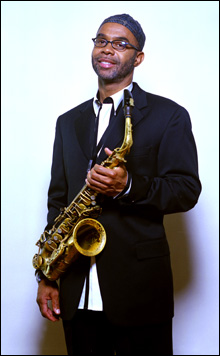
THE TOUCH: Like Coltrane, Tyner, besides having speed and power, has always had something else. |
“I’m playing changes!” That’s what a young jazz-pianist acquaintance of mine announced exultantly to one of his musical buddies back in the early ’70s.It was a funny thing to say. Jazz musicians cut their teeth on changes, the chord progressions that underlie the structure of every tune. So the young pianist was supposed to be playing changes. The reason he hadn’t been can be attributed to one man: McCoy Tyner.
Or maybe two, the other being John Coltrane. Coltrane’s quartet of 1960-’65 with Tyner, bassist Jimmy Garrison, and drummer Elvin Jones is considered the most influential band in the history of jazz. And together they helped make modal jazz central to the mainstream. Rather than playing “changes,” the band would play modal scales over a single chord for . . . as long as they wanted. As the saying goes, not everything in a piece of music can be complicated. You can play complex rhythms, complex melodies, complex harmonies — but not all at once, or the density of the piece becomes impenetrable.
The Coltrane Quartet pushed the idea of playing extended complex scalar patterns over ever-increasing free rhythms and a simple, grounding drone figure. It was Tyner’s job to state that grounding drone in his left hand with alternating sevenths and 10ths the way a sarod establishes the underlying drone of Indian music.
Part of what was attractive to young musicians following in the Coltrane Quartet’s wake was that with such a procedure you could play just about any melodic pattern and have it be correct, or at least not wrong. But correct isn’t always interesting. So for every Joe Farrell or Dave Liebman or Michael Brecker — saxophonists who were able to create their own identities within the sphere of Coltrane’s influence — there were scores of reedmen who sounded like verbose imitators, spinning their wheels on exercise-book patterns. And aside from Joanne Brackeen, most Tyner stylists of the era are lost to memory. Modal jazz may be easier to learn how to play, but it’s not easy to make interesting — and there are no shortcuts to Coltrane’s singular spiritual intensity.
One thing we’ve learned is that it isn’t just a matter of loud and fast, either. Like Coltrane, Tyner (who comes to the Berklee Performance Center this Saturday with a septet as part of the BeanTown Jazz Festival) has always had something else. He’s always had the rumbling power and lightning finger speed to hold his own with drummers as dynamic as Jones and a tenor as big as Coltrane. But Tyner also has that one indefinable thing that not many jazz pianists have: touch. A piano just sounds different when he plays it, no matter what the individual notes or chords. From the very first chord, the piano sounds like a Tyner piano in a way that has nothing to do with power or volume. In his own way, his touch is as distinctive as Hank Jones’s. Coltrane attributed Tyner’s sound to his particular voicings of chords and clusters — something that made even familiar chord progressions sound distinctive.
“You have to have some talent!”, Tyner laughs when I press him on the issue over the phone from his home on New York’s Upper East Side. “I don’t think you can do too much without that.” Tyner points out that the piano is essentially percussive, and he says that his own rhythmic dexterity is attributable to his early years playing conga drums. (He gave it up because he was hurting his hands.) But he adds that he studied all kinds of music growing up. “I had books of Chopin, I had the R&B experience, I played for a dance school, did some Latin things. I had a well-rounded background. But touch is very, very important. It’s not necessarily technique, it’s how you embrace the instrument. And how you use the pedals, and all those things, that determine your sound.”

DEVOTION: Garrett’s The Great Wall pays homage to China, but the touchstone throughout is Coltrane. |
What’s also sometimes forgotten is that Tyner, like Coltrane, was not exclusively a modal player, and that the modal experiment was an extension of their encyclopedic knowledge of harmony. Hearing Tyner play with his big band in the ’90s, I was struck by how his style reached back past his immediate predecessors and heroes, Bud Powell and Thelonious Monk, to the full chordal style and stride rhythms of Art Tatum. And you can hear that too on his 2000 tribute album, Roots (Telarc). “Art set a precedent for pianists because he really played the instrument completely. But I do think that what belongs to you, your identity, your personality, has a lot to do with your sound. I was a pretty stubborn guy: I always wanted to sound like myself, even though I was influenced by people like Oscar Peterson, Teddy Wilson, and Art influenced all of us. But I never wanted to be like him or wanted to play Art’s licks. But some people influence you so much because the artistry is on such a high level, and Art was like that.”At Berklee, Tyner will be working with the touring “Story of Impulse Records” band, whose members in this incarnation will include Dave Liebman, Donald Harrison, Wallace Roney, Steve Turre, Charnett Moffett, and Eric Kamau Gravatt. For a complete timetable of BeanTown events, including a panel discussion on Impulse Records with Liebman and author Ashley Kahn, visit www.beantownjazz.org.